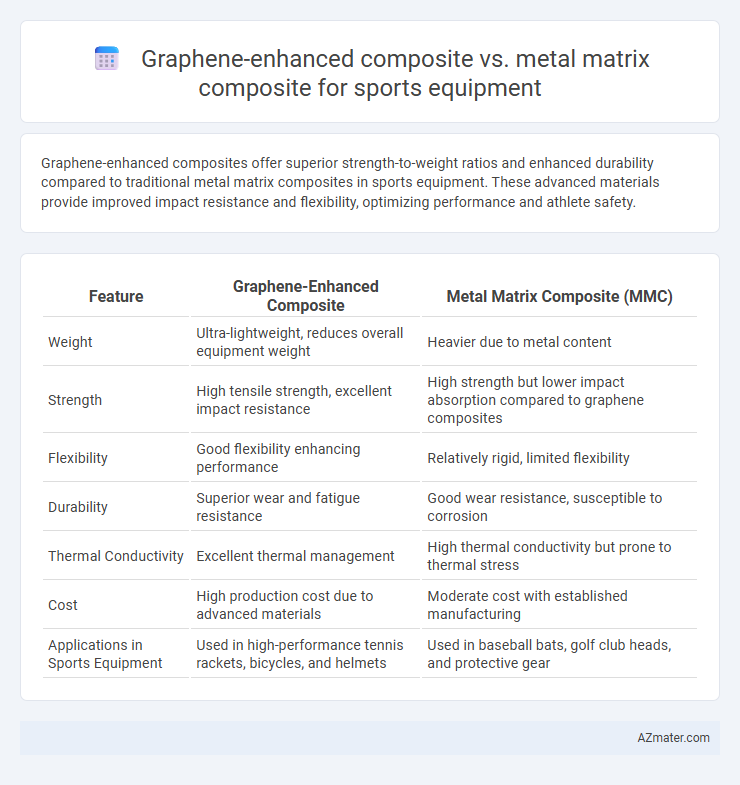Graphene-enhanced composites offer superior strength-to-weight ratios and enhanced durability compared to traditional metal matrix composites in sports equipment. These advanced materials provide improved impact resistance and flexibility, optimizing performance and athlete safety.
Table of Comparison
| Feature | Graphene-Enhanced Composite | Metal Matrix Composite (MMC) |
|---|---|---|
| Weight | Ultra-lightweight, reduces overall equipment weight | Heavier due to metal content |
| Strength | High tensile strength, excellent impact resistance | High strength but lower impact absorption compared to graphene composites |
| Flexibility | Good flexibility enhancing performance | Relatively rigid, limited flexibility |
| Durability | Superior wear and fatigue resistance | Good wear resistance, susceptible to corrosion |
| Thermal Conductivity | Excellent thermal management | High thermal conductivity but prone to thermal stress |
| Cost | High production cost due to advanced materials | Moderate cost with established manufacturing |
| Applications in Sports Equipment | Used in high-performance tennis rackets, bicycles, and helmets | Used in baseball bats, golf club heads, and protective gear |
Introduction to Advanced Composites in Sports Equipment
Graphene-enhanced composites offer exceptional strength-to-weight ratios, superior flexibility, and improved impact resistance, making them ideal for high-performance sports equipment like tennis rackets and bicycle frames. Metal matrix composites provide enhanced durability, thermal stability, and stiffness, which benefit sports gear such as golf clubs and protective helmets. Both materials revolutionize equipment design by combining lightweight properties with increased mechanical performance, optimizing athletic efficiency and safety.
What is Graphene-Enhanced Composite?
Graphene-enhanced composites integrate graphene nanosheets into polymer or metal matrices to significantly improve mechanical strength, flexibility, and thermal conductivity, making them highly suitable for advanced sports equipment. These composites offer superior lightweight properties and impact resistance compared to traditional metal matrix composites, enhancing performance and durability in applications like tennis rackets, bicycle frames, and protective gear. The incorporation of graphene facilitates enhanced wear resistance and energy absorption, which is critical for high-performance sports technologies.
Overview of Metal Matrix Composites (MMC)
Metal Matrix Composites (MMCs) are engineered materials consisting of a metal matrix reinforced with ceramic or other materials to enhance strength, stiffness, and wear resistance, making them ideal for high-performance sports equipment. Common metal matrices include aluminum, magnesium, and titanium, chosen for their lightweight and superior mechanical properties, while reinforcements such as silicon carbide or alumina improve durability and impact resistance. MMCs offer advantages like improved thermal conductivity and fatigue resistance compared to traditional metals, contributing to enhanced performance and longevity in applications like bicycle frames, golf clubs, and tennis rackets.
Key Material Properties: Strength, Weight, and Durability
Graphene-enhanced composites exhibit superior strength-to-weight ratios compared to traditional metal matrix composites, offering significantly reduced weight while maintaining exceptional tensile strength and flexibility crucial for high-performance sports equipment. These composites provide enhanced durability through improved impact resistance and fatigue life, outperforming metal matrix composites which tend to be heavier and more prone to corrosion. The integration of graphene results in materials that deliver optimal performance in terms of stiffness, lightweight design, and long-term resilience, making them ideal for advanced sports gear manufacturing.
Performance Comparison: Flexibility and Impact Resistance
Graphene-enhanced composites exhibit superior flexibility and impact resistance compared to traditional metal matrix composites, making them ideal for high-performance sports equipment. The exceptional tensile strength and lightweight nature of graphene improve shock absorption and reduce fatigue, enhancing athlete safety and comfort. Metal matrix composites, while durable, often lack the same degree of flexibility, limiting their effectiveness in applications requiring rapid movement and dynamic stress tolerance.
Manufacturing Processes and Scalability
Graphene-enhanced composites in sports equipment manufacturing leverage advanced techniques like chemical vapor deposition and solution processing to achieve superior strength-to-weight ratios with enhanced scalability for mass production. Metal matrix composites (MMCs) typically require energy-intensive processes such as powder metallurgy and casting, which can limit scalability due to higher costs and complex tooling demands. Graphene composites offer more flexible manufacturing processes that enable efficient scaling while maintaining performance advantages over traditional MMCs in applications like tennis rackets, bicycle frames, and protective gear.
Cost-Effectiveness and Market Availability
Graphene-enhanced composites offer superior strength-to-weight ratios and enhanced durability compared to traditional metal matrix composites, making them highly cost-effective for high-performance sports equipment despite currently higher material costs. Metal matrix composites remain more widely available and affordable due to established manufacturing processes and supply chains, catering to a broader market segment. The evolving production scalability of graphene composites is expected to reduce costs and increase market availability, positioning them as a competitive alternative in future sports equipment manufacturing.
Applications in Popular Sports Equipment
Graphene-enhanced composites deliver superior strength-to-weight ratios and enhanced fatigue resistance, making them ideal for high-performance tennis rackets, bicycle frames, and golf club shafts. Metal matrix composites offer excellent thermal stability and impact resistance, commonly used in baseball bats and hockey sticks to withstand repeated force and vibration. The integration of graphene into polymer matrices significantly improves flexibility and durability, while metal matrix composites prioritize stiffness and power transfer in aggressive sports applications.
Environmental Impact and Sustainability
Graphene-enhanced composites exhibit superior environmental benefits over traditional metal matrix composites in sports equipment due to their lighter weight, which reduces energy consumption during manufacturing and transportation. The high strength-to-weight ratio of graphene composites leads to increased durability and longer product life, minimizing waste generation and resource depletion. Metal matrix composites typically require more energy-intensive production and recycling processes, contributing to a larger carbon footprint and greater environmental impact.
Future Trends and Innovations in Sports Material Science
Graphene-enhanced composites deliver superior strength-to-weight ratios and enhanced flexibility, revolutionizing sports equipment by enabling lighter, more durable products that improve athlete performance. Metal matrix composites offer exceptional wear resistance and thermal stability but often lack the weight advantages critical for competitive sports gear. Future trends emphasize hybrid materials integrating graphene's nanostructures with metal matrices to create innovative sports equipment that balances lightweight agility with mechanical robustness.

Infographic: Graphene-enhanced composite vs Metal matrix composite for Sports equipment
 azmater.com
azmater.com